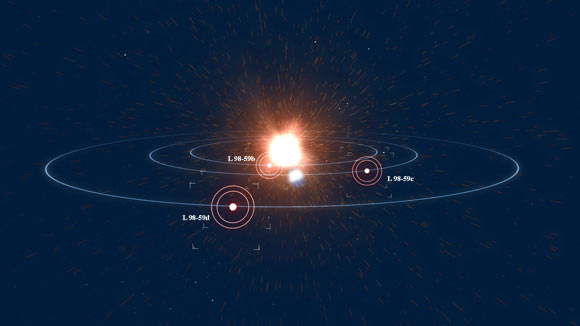Astronomers using NASA’s Transiting Exoplanet Survey Satellite (TESS) have discovered three small planets orbiting a bright M-dwarf star called L 98-59. One of these planets, L 98-59b, is the smallest yet discovered by the TESS mission.

An artist’s conception of the L 98-59 planetary system. Image credit: NASA’s Goddard Space Flight Center.
L 98-59, also known as TOI-175, TIC 307210830, is an M dwarf about one-third the mass of the Sun.
It lies about 34.5 light-years away in the southern constellation Volans and is orbited by at least three planets: L 98-59b, c and d.
The innermost planet, L 98-59b, is around 80% Earth’s size and about 10% smaller than the previous record holder discovered by TESS.
It orbits every 2.25 days, staying so close to the host star it receives as much as 22 times the amount of energy Earth receives from the Sun.
The two other worlds in this system, L 98-59c and L 98-59d, are around 1.4 and 1.6 times Earth’s size, respectively.
L 98-59c, the middle planet, orbits every 3.7 days and experiences about 11 times as much radiation as Earth.
L 98-59d, the farthest planet identified in the system, orbits every 7.5 days and is blasted with around four times the radiant energy as Earth.

L 98-59b, c and d are compared to Mars and Earth in order of increasing size in this illustration. Image credit: NASA’s Goddard Space Flight Center.
None of the planets lie within the star’s habitable zone,’ the range of distances from the star where liquid water could exist on their surfaces.
However, all of them occupy what scientists call the Venus zone, a range of stellar distances where a planet with an initial Earth-like atmosphere could experience a runaway greenhouse effect that transforms it into a Venus-like atmosphere.
Based on its size, L 98-59d could be either a Venus-like rocky world or one more like Neptune, with a small, rocky core cocooned beneath a deep atmosphere.
“If we viewed the Sun from L 98-59, transits by Earth and Venus would lead us to think the planets are almost identical, but we know they’re not,” said Dr. Joshua Schlieder, from NASA’s Goddard Space Flight Center.
“We still have many questions about why Earth became habitable and Venus did not. If we can find and study similar examples around other stars, like L 98-59, we can potentially unlock some of those secrets.”
“The discovery is a great engineering and scientific accomplishment for TESS,” said Dr. Veselin Kostov, from NASA’s Goddard Space Flight Center and the SETI Institute.
“For atmospheric studies of small planets, you need short orbits around bright stars, but such planets are difficult to detect. This system has the potential for fascinating future studies.”
A paper reporting this discovery is published in the Astronomical Journal.
_____
Veselin B. Kostov et al. 2019. The L 98-59 System: Three Transiting, Terrestrial-size Planets Orbiting a Nearby M Dwarf. AJ 158, 32; doi: 10.3847/1538-3881/ab2459







